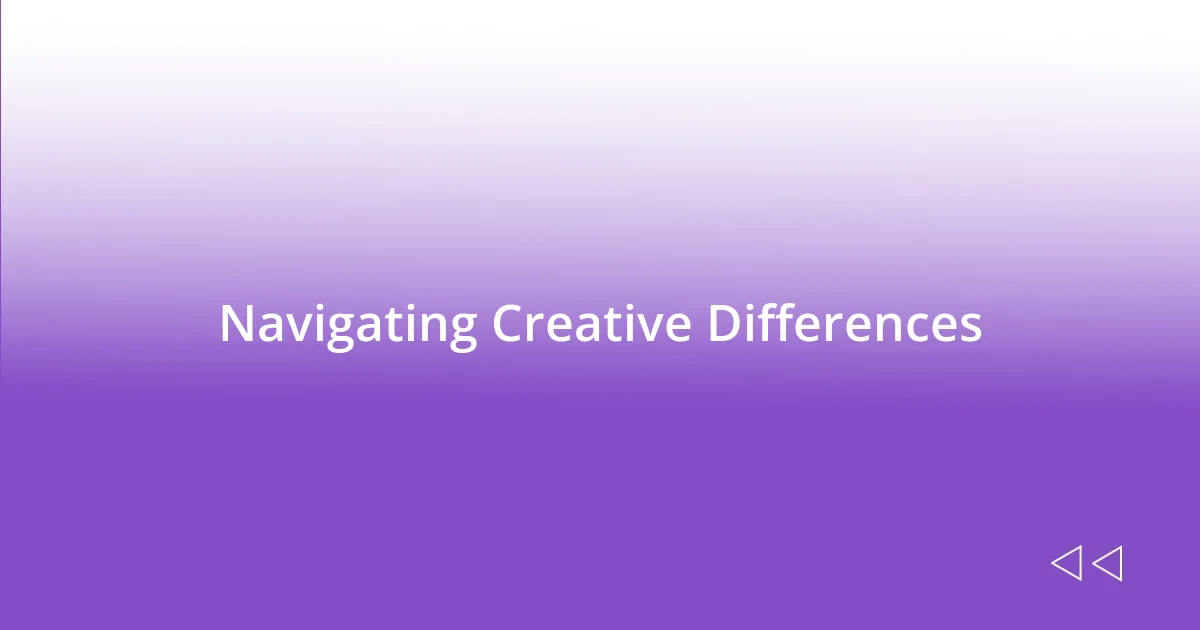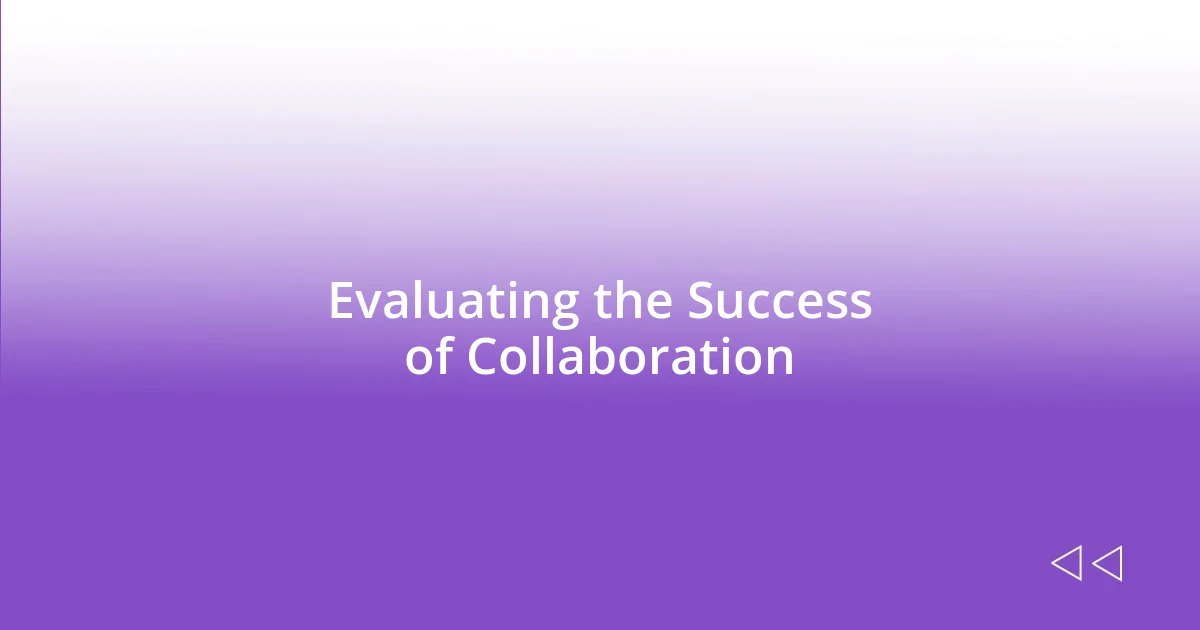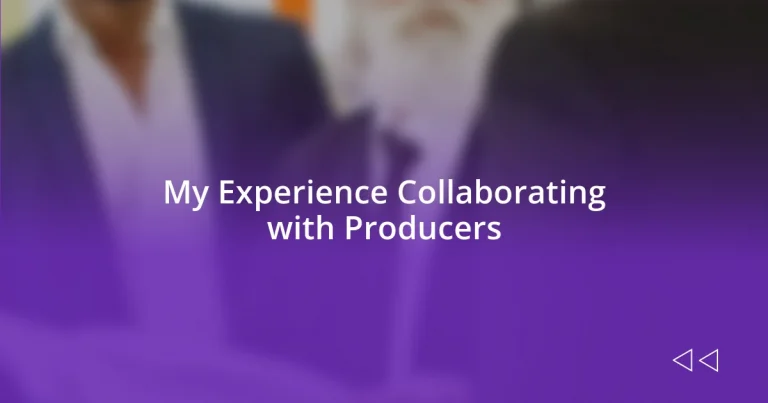Key takeaways:
- Producers play a crucial role in coordinating projects, managing interpersonal dynamics, and enhancing creativity, significantly impacting the final outcome.
- Establishing clear communication channels, including regular check-ins and active listening, fosters trust and better collaboration among team members.
- Reflecting on experiences, such as embracing flexibility and nurturing open discussions, deepens understanding and strengthens future collaborative efforts.

Understanding the Role of Producers
The role of producers in any creative project is nothing short of pivotal. They are the project’s driving force, coordinating everything from budgeting to scheduling, and ensuring that the final product aligns with the original vision. In my experience, a good producer is like a conductor, bringing together diverse talents to create a harmonious outcome.
One thing I often marveled at during my collaborations is how producers navigate complex interpersonal dynamics. I recall a particularly heated discussion in a meeting where creative differences threatened to derail our progress. The producer skillfully defused the situation, merging ideas and ensuring everyone felt heard. Isn’t it fascinating how these behind-the-scenes strategists can transform tension into teamwork?
Producers also wear many hats, sometimes acting as creative gatekeepers. Their insights can push a project to new heights or, conversely, challenge your comfort zone. I once had a producer request a complete rework of a segment I was passionate about. At first, I resisted, but ultimately, that collaboration deepened my understanding of the audience’s perspective, and what emerged was something I was even prouder to be a part of. It really showcased how vital their input can be!

Establishing Clear Communication Channels
Establishing open communication channels with producers is essential for any successful collaboration. I remember working on a project where we set up regular check-ins that allowed everyone to voice concerns and share updates. This system not only kept us aligned but also built trust among team members, making it easier to navigate creative challenges as they arose.
In another instance, I learned the importance of utilizing various communication tools. We experimented with instant messaging, project management apps, and video calls. Ultimately, finding balance in our communication helped streamline discussions and fostered a sense of community, even when working remotely. Have you ever felt that a simple tool could dramatically change the course of a project? I certainly have experienced moments where clarity in communication was the key to avoiding misunderstandings and keeping morale high.
Lastly, I can’t stress enough the value of active listening when communicating with producers. There was a time when I hurried to express my ideas without pausing to truly listen to the producer’s feedback. Once I shifted my approach to really hear their perspective, everything changed. This not only improved our collaborative efforts but also led to innovative solutions that I wouldn’t have considered on my own. Isn’t that an enlightening realization about the power of communication?
| Communication Method | Benefits |
|---|---|
| Regular Check-ins | Builds trust and keeps everyone aligned. |
| Communication Tools | Streamlines discussions and keeps team connected. |
| Active Listening | Enhances collaboration and discovers innovative solutions. |

Setting Expectations for Collaboration
Setting expectations for collaboration is crucial and can shape the entire project experience. One project that stands out to me involved clearly defining roles and responsibilities right from the start. By mapping out who would handle what, we minimized overlaps and confusion, which is often where collaboration can go awry. I found that when everyone knows their part, it fosters accountability and motivation, creating a more cohesive atmosphere.
To make sure we were on the same page, we set some ground rules at the beginning:
- Communication Protocol: We established how often we would update each other and the best methods to use.
- Decision-Making Process: Defining who has the final say on critical aspects helped avoid potential conflicts.
- Feedback Loops: We agreed on regular checkpoints for constructive criticism, ensuring everyone’s voice was valued.
Looking back, I see how these expectations not only enhanced our workflow but also built a level of camaraderie that made the challenging moments much easier to navigate together.

Navigating Creative Differences
Creative differences can be daunting, but I’ve found that embracing them often leads to the best results. I remember a project where our ideas clashed; I suggested a bold direction while the producer advocated for a more traditional approach. Instead of letting tension build, we exchanged our viewpoints openly, which ultimately fostered a compromise that blended both our visions. Have you ever felt stuck in your creative bubble, only to realize that collaboration opens up new avenues?
In another instance, midday brainstorming sessions became our secret weapon. When we faced opposing ideas, we’d gather around the table—and surprisingly, shifting our environment shifted our mindset. It’s amazing how a little change, like altering our location from the office to a café, encouraged more fluid conversations and allowed us to see things through each other’s lens. What’s your go-to method for sparking creativity when differences arise?
I’ve also learned that humor can act as a bridge. During a particularly heated exchange, I cracked a joke about my inflexible ideas being like a stubborn block of cheese—hard on the outside but surprisingly soft inside. Laughter not only eased the tension but reminded us that, ultimately, we’re all working towards a common goal. It’s a simple yet profound lesson: sometimes, navigating creative differences means remembering to enjoy the journey together.

Evaluating the Success of Collaboration
Evaluating the success of collaboration can often feel like peering into a crystal ball. I’ve learned to quantify our outcomes using clear metrics, such as meeting deadlines and the quality of the final product. In one memorable collaboration, we not only met our timeline but exceeded our creative goals, which felt immensely rewarding. Have you ever experienced a project where the final result was unexpectedly rich? It’s moments like these that validate the hard work put in by every team member.
However, success isn’t just about the visible results; it’s also about the relationships built along the way. After a project wrapped up, I took the time to gather feedback from the producers involved. The insights I gained were eye-opening; many echoed a sense of fulfillment and growth, which was a testament to the collaborative process itself. It made me realize that fostering a positive environment can lead to personal and collective success—something that often transcends the scope of the work.
On the flip side, I’ve encountered collaborations that didn’t quite hit the mark. In one situation, despite our best efforts, communication breakdowns led to unproductive meetings and frustration. Reflecting on those experiences illuminated the importance of evaluating not just the final outcomes but also the day-to-day interactions. How we communicate can redefine our collaboration journey, teaching us valuable lessons for future projects. What has your experience been like when a collaboration didn’t go as planned?

Reflecting on Lessons Learned
Reflecting on lessons learned in collaboration often highlights the importance of adaptability. I remember working on a project that initially felt like a ship lost at sea; we had a strong team, but uncertainty clouded our direction. It was during a late-night discussion that we decided to pivot our approach entirely. This experience taught me that flexibility is not weakness—it’s a strength that can lead to unexpected breakthroughs. Have you ever turned a potential setback into an opportunity?
One key takeaway for me was the power of vulnerability. In one collaboration, I hesitated to share my doubts about our direction, thinking it might undermine my credibility. But when I finally voiced my concerns, I was met with support and understanding, which led us to a valuable discussion. This taught me that being open about challenges creates stronger bonds and fosters an atmosphere of trust. How often do we let fear of judgment hold us back from speaking our minds?
Lastly, I’ve realized that every project offers a unique lesson, whether positive or negative. I once worked with a passionate producer whose commitment pushed us all to deliver our best, but it also led to unrealistic expectations that created tension. Reflecting on that experience has helped me appreciate the balance between enthusiasm and practicality. Every collaboration, regardless of its outcome, equips us with insights that shape our future endeavors. What lessons have stuck with you, even from less-than-perfect collaborations?














